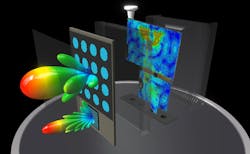The 7 Pillars of 5G/6G RF System Design (Part 1)
This article is part of the TechXchange: Software & Design Tools.
Members can download this article in PDF format.
What you’ll learn:
- The many technical factors that must be assessed in 5G antenna design, including their interactions.
- Further physical/environmental considerations for both the antenna and the entire system.
In the Old Testament’s Book of Proverbs, the first verse of the ninth chapter is simultaneously enigmatic and captivating: "Wisdom has built her house; she has set up its seven pillars." The verse has been referenced frequently and in a broad variety of ways over the centuries.
Regardless of how interpretations of the verse may vary, all reflect an underlying understanding—that creative success requires planning, expertise, insight, inspiration, using the proper instruments, and above all, a commitment to achieve value that’s both exceptional and unique.
We can logically extend the above to any endeavor in High Technology, and particularly to one of the leading sectors for innovation at the chip, system, and software level: RF communication systems in 5G/6G. At the heart of these communications systems lies the physical layer, involving modulation, transmission, and de-modulation of signal and data content over the wireless channel. Operating the physical layer reliably has implications on the total cost of ownership (TCO) of the equipment, which is the single overriding concern for the customer service provider (CSP) purchasing, operating, and maintaining that equipment.
What, then, are the pillars that serve as major considerations in 5G/6G physical-layer design?
1. RF power
This is usually a major driver for both the design and operating cost of the base station or mobile device. RF power is what enables the communication system to be heard at increasing ranges—more RF power from the transmitter usually results in more range.
RF power received by a mobile device is usually a combination of the base-station transmitter power and the relative directivity of the antenna on each end. This leads to an interesting tradeoff between an antenna’s ability to focus the RF power that’s radiated, and the RF power generated in the antenna. Generating RF power also results in generating heat, which leads to other multi-physics challenges like mechanical expansion and stress.
Allowable RF power radiated by an access point or device is subject to regulatory control, too, which governs topics like exposure safety and potential for interference to other RF systems.
2. Antenna sizing
There’s nothing trivial about deciding how big an antenna will be. In general, a larger antenna will exhibit higher directivity, and it can offer an operational RF link with lower RF power than a smaller antenna. Indeed, base-station antenna systems consist of multi-element antenna arrays, leading to beamforming capabilities that enable the antenna to focus the signals spatially on subscribers. These antenna systems may be arbitrarily large, but considerations such as wind loading, tower mount weighting, and multi-band service also drive size and weight considerations.
Heavier antenna systems require more costly towers and installation mount points. Larger arrays with more elements require more supply power, driving up the operational electric bill. Generation and distribution of RF power across these arrays can be costly, and they will incur power loss from source to antenna that must be made up by the RF transmitter. Passive cooling and heatsinks must be considered in the overall size and weight.
Antennas in mobile devices must fit tight form-factor requirements, which often drive difficult design and integration challenges. Further, the package integration may reduce radiation efficiency—power loss that must be made up by increasing power at the expense of battery life. Mobile device antennas also are subject to strict emissions standards for personal health, safety, and coexistence with other RF systems.
3. Antenna agility and beamforming
Antennas form the interface that matches the radio electronics to the physical environment, which forms the wireless channel. Choose that antenna poorly, and the receiver on the other end of the channel will fail to detect the signal. Design the antenna well, and you can minimize the cost you invest in both the transmitter and the receiver.
Antenna systems composed of many antenna elements (phased arrays) offer the ability to shape the way RF power is physically projected into the environment. By using techniques such as polarization diversity and beamforming, we can enhance the number of simultaneous pathways for RF signals to traverse the environment to serve more users with better throughput.
Methodologies like multi-user massive multi-input/multi-output (MU-mMIMO) are gaining traction in enabling base-station arrays and mobile devices to support high levels of service. These agility techniques don’t come for free—they require a great deal more baseband processing, putting pressure on the power and complexity of the packaged digital and RF electronics within the base station or mobile device.
4. RF bandwidth
It’s true—there’s a direct relationship between the bandwidth of an RF communication channel and the amount of data that can be sent over it. Double the RF channel bandwidth and you double the data that can be sent over it. Expanding bandwidth leads to new challenges acutely felt by the RF and antenna system designer.
Compact, efficient antennas are naturally narrowband devices—they must be carefully designed to be efficient radiators over wide bandwidths, or multiple antenna systems will be required to serve each band (another tradeoff!). Availability of wideband RF channels is scarce at low microwave frequencies, but more widely available at mid-microwave and mmWave frequencies (where wideband is easier to manage in a fractional bandwidth of carrier frequency sense).
Higher-frequency systems require more cost and care to design and exhibit reduced power-added efficiency (the ability of the transmitter to efficiently convert supply power to RF power). Wider bandwidths drive the need for digital receivers to sample at considerably higher rates, leading to elevated power consumption, more digital data to process, and added complexity to the packaged electronics in the baseband processor.
5. RF waveform selection
Developing RF systems to leverage an available or licensed bandwidth is one thing, but how that spectrum is used is another. The RF modulation technique (how we put information onto an RF carrier for transmission) will drive a metric called “spectrum efficiency.”
Spectrum efficiency is usually expressed in bits/hertz (b/Hz, or b/MHz), and tells us something about how much digital data our RF system can push through the available RF channel bandwidth at a prescribed error rate. This depends on factors like the digital modulation scheme, the number and spacing of reference or data subcarriers used in the waveform, signal-to-noise and signal-to-interference ratios in the channel, and the transmission symbol rates employed in both time and frequency division.
It’s an area of extensive research. In 6G systems, it may be possible for future RF systems to dynamically adjust their waveforms through artificial intelligence and machine learning (AI/ML) to reactively counter dynamic wireless channel behavior as the physical environment changes and as users (or other independent bodies) move.
6. Receiver design
Good receivers have two salient characteristics: they detect weak signals, and they reject unwanted signals (interference). Today’s receivers are increasingly digital, and architectures are coming forward that place one at each base-station element or at sub-groups of elements for enhanced flexibility.
Mobile device receivers must contend with noisy RF environments, small and inefficient form factors for integration and must operate continually to monitor the channel for incoming calls or targeted data. Low-noise RF front ends often require high current bias, making continual operation an enemy of the battery.
7. Bespoke wireless channel modeling
Legacy RF communication systems employed in 3G and 4G systems have been constrained to bands < 2500 MHz. The past 40 years of wireless telecommunications have provided us with voluminous measurement data for characterizing RF wireless propagation through dense urban and terrestrial settings.
At these frequencies, signals tend to propagate with reasonable predictability through and around buildings and terrain. Many proven empirical and statistical channel models have provided RF communication system designers with the utility they need to test RF chain and signal-processing concepts.
As 5G and 6G systems arise, they’re using high-frequency bands where RF propagation models are less reliable. Higher frequencies make wider bandwidths possible and usable. The environment becomes more reflective and less penetrable by RF signals, leading to stronger multi-path and diffraction effects. Propagation losses mount over physical distance with increasing frequency, leading to the need for larger antennas.
The lack of reliable wireless channel models at higher frequencies necessitates modeling the physics of RF scattering at the specific bas- station location, and to the locations of subscribers (and interferers). With accurate wireless channel modeling customized to a specific location, telecom system providers can customize all aspects of a wireless access point for the lowest total cost of ownership. This would optimize all six of our previous categories to meet key performance indicators for minimum total design and operational cost.
What’s the Prognosis?
One can readily discern that these pillars are significantly more complex in terms of instantiation than for most problems because of their evident dynamic interactivity and interdependence. Furthermore, many advanced design options and their attendant issues are subject to significant repercussions from these primary design pillars.
Such repercussions include channel latencies, the “densification” of hierarchical networks (from femtocells and microcells up to base stations and the extension to air- and space-based non-terrestrial/satellite nodes), edge processing, the downstream impact on 6G, implications for optical backhaul and consequences to processing support (including asymmetric heterogeneous multiprocessing), to name a few.
With all this in mind, what is the path of wisdom a design team should follow for building the pillars for a house such as this? We will discuss them all in a series of articles that will give each topic justice. The next installment of this series will detail the first pillar described above: RF Power.
If you want to learn more about the role of Computational Electromagnetic simulation in 5G system design, click here.
Read more articles in the TechXchange: Software & Design Tools.



